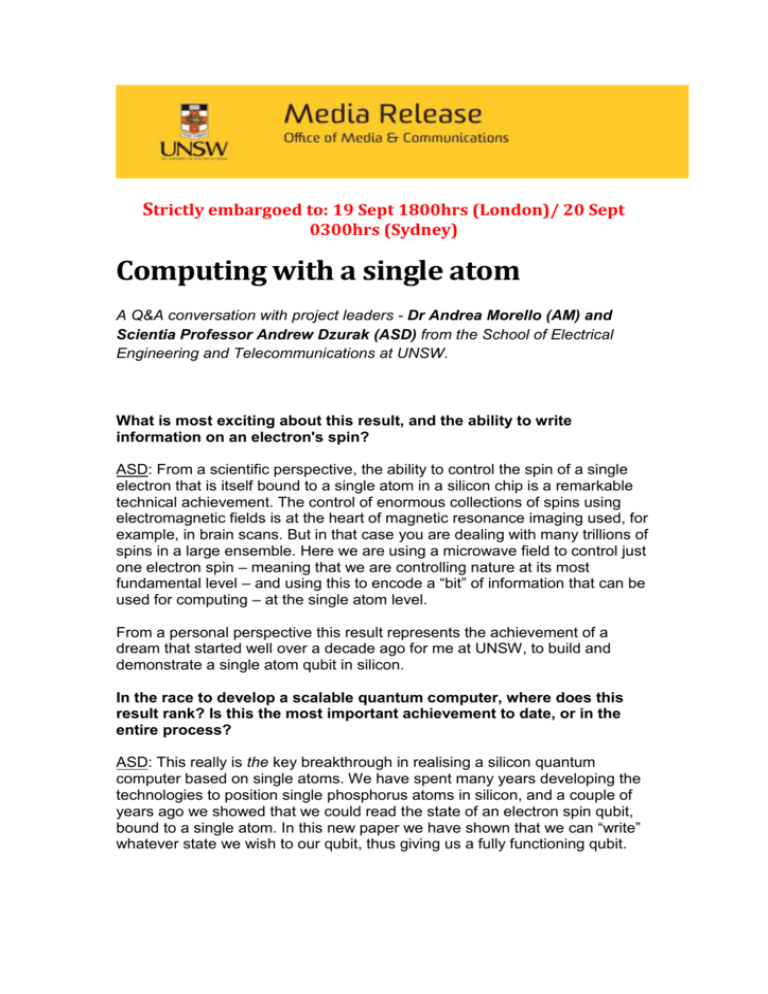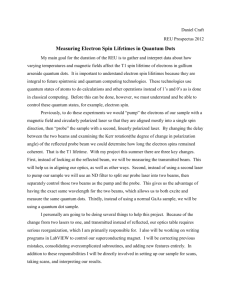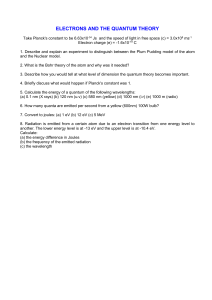Computing with a single atom
advertisement

Strictly embargoed to: 19 Sept 1800hrs (London)/ 20 Sept 0300hrs (Sydney) Computing with a single atom A Q&A conversation with project leaders - Dr Andrea Morello (AM) and Scientia Professor Andrew Dzurak (ASD) from the School of Electrical Engineering and Telecommunications at UNSW. What is most exciting about this result, and the ability to write information on an electron's spin? ASD: From a scientific perspective, the ability to control the spin of a single electron that is itself bound to a single atom in a silicon chip is a remarkable technical achievement. The control of enormous collections of spins using electromagnetic fields is at the heart of magnetic resonance imaging used, for example, in brain scans. But in that case you are dealing with many trillions of spins in a large ensemble. Here we are using a microwave field to control just one electron spin – meaning that we are controlling nature at its most fundamental level – and using this to encode a “bit” of information that can be used for computing – at the single atom level. From a personal perspective this result represents the achievement of a dream that started well over a decade ago for me at UNSW, to build and demonstrate a single atom qubit in silicon. In the race to develop a scalable quantum computer, where does this result rank? Is this the most important achievement to date, or in the entire process? ASD: This really is the key breakthrough in realising a silicon quantum computer based on single atoms. We have spent many years developing the technologies to position single phosphorus atoms in silicon, and a couple of years ago we showed that we could read the state of an electron spin qubit, bound to a single atom. In this new paper we have shown that we can “write” whatever state we wish to our qubit, thus giving us a fully functioning qubit. AM: you can think of this result as the “quantum equivalent” of having built the first transistor. It’s not a computer yet, but it’s the landmark that allows you to confidently think you will one day build a computer with it. What is the next step toward developing a quantum computer, and what still needs to be done before this goal is realised? AM: We are already working on the next logical step, which is to couple two qubits together to demonstrate a quantum logic operation. The way this is obtained is, again, peculiar of a truly quantum system. We will put two atoms so close together that the electrons bound to them start to “overlap”, share some of the space they occupy. This results in a magnetic interaction between them, that you can control and use for computer operations. ASD: There are many engineering steps beyond this to build a full-scale quantum computer. To put this in perspective, Bardeen, Brattain and Shockley at Bell Labs demonstrated the first transistor in 1947, but it took another two decades before a full-scale microprocessor was demonstrated. I would say it will be at least a decade before a demonstrator system is built that can solve useful problems that current supercomputers cannot – and even longer, maybe 20 years, before commercial products are available. The timescales for quantum computing are long because the physical challenges, namely controlling single atoms and electrons, are so difficult, but the potential outcomes promise to be revolutionary for the future of information processing. Can you talk about the approach of using silicon as a bulk material – why has UNSW taken this approach rather than exploring other more exotic base materials or approaches? ASD: The approach that our Center has taken for the past decade has focused on using single atoms of phosphorus, embedded in a silicon chip, to define the quantum bits of a future processor. More specifically, we use the “spin”, or magnetic direction, of an electron that is bound to the phosphorus atom to encode the quantum bit of information. A spin pointing “down” represents a “0” and a spin pointing “up” encodes a “1”. AM: We have focused on silicon for two reasons: Firstly, the electron spin qubit retains its delicate quantum information for a long time (known as the “coherence time”) before it is scrambled and lost, as compared with other materials. Secondly, silicon is the material from which all modern day computer processor chips are made, and the technology for manufacturing billions of electronic devices on a single chip has been developed over the past four decades with trillions of dollars of investment by the global computer industry. By using silicon as our base material we are able to leverage off this investment and existing technology, and we are in a much better position than other strategies to transfer our technology to industry. What will functional quantum computers do that current PC's and even supercomputers cannot? AM: Conventional supercomputers work by wiring up thousands of individual processor chips in parallel, with each processor working on one possible solution to a problem. In contrast, quantum computers have an inherent ability to solve problems in a “parallel” way, trying out trillions of different solutions at the same time, with the same physical processing unit. They are able to do this because quantum particles, such as photons or electrons, can exist in states that have no classical analog, and they can be in many of such states at the same time. These special states are called “entangled states” because the information they contain tells you something about the correlations between the particles, but not the individual state of each particle. As we add qubits to the computer, the amount of information stored rises exponentially. With just 300 physical qubits the amount of information stored is roughly equivalent to the total number of atoms in the universe! Quantum computers are therefore suited to solving extremely complex problems, with many different variables. The important point to keep in mind is that a quantum computer can be exponentially fast not because its “clock speed” is very high, but because it can run a completely different “software”. In other words, the number of operations necessary to solve certain problems on a quantum computer can be exponentially smaller than on a classical one, whereas the speed of each individual operation is not important. Can you give some examples of problems they will be able to solve faster, or more effectively? ASD: Examples include the simulation of complex molecules, which can be used for designing new types of targeted pharmaceuticals, or searching very large databases, perhaps leading to something akin to a “quantum Google”. The other key area where they will be much faster than classical computers is for cracking most forms of modern encryption. There are also some possible applications that will only be realised once these things are up and running – can you speculate on what some of these might be? AM: A very exciting scenario will arise when small quantum computers can – or must! – be used to simulate and design larger ones. In other words, one can envisage a point where the complexity of the next generation of quantum computers will be such that no classically-coded supercomputer can handle the problem. When that is the case, we will be in for big surprises in science! The other big endeavour is the study of biological processes from first principles. At this stage, no computer can calculate the exact properties of molecules larger than, say, caffeine. This is a long way from what’s relevant in living cells. There is hope that the ability of quantum computers to simulate complex systems that are fundamentally quantum mechanical will help making light on the microscopic aspects of life. Can you tell me about the role that the Australian National Fabrication Facility played in this research? The Australian National Fabrication Facility was established six years ago, with significant funding from the Australian federal and state governments, to provide nanofabrication capabilities to all Australian researchers. For our project, we used the ANFF in making just about all parts of our silicon chip, in particular the nano-scale gate electrodes that make the single-electron transistor spin reader – and also the on-chip microwave antenna that controls the spin of the single electron qubit. Why is this type of research and fabrication infrastructure so important to Australia’s high-technology future? Nanotechnology is recognised around the world as a game-changing technology that will impact many areas of life in the future – from the new computing capabilities we hope will be realised by our research – to new types of medical devices that can be used to detect disease or to help cure us when we fall ill. The ANFF is a truly world-leading facility that is supporting over 1000 leading researchers around the country. As such it is absolutely vital to the economic and social future of Australia.







